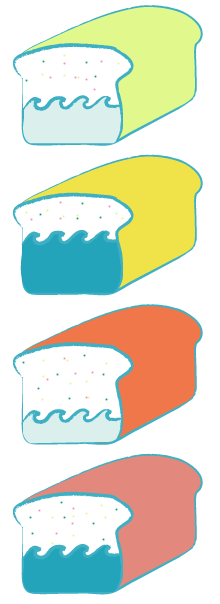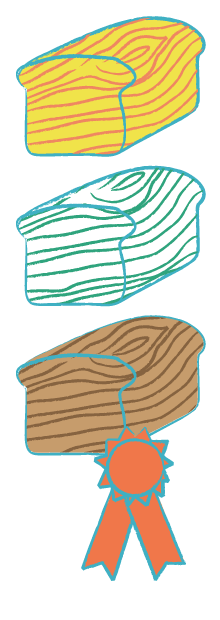Pro Tip: Make sure the oven is on.
As I scribble that into my notebook, I think, for the first time in what feels like months of failure, I can do this — I can bake. I’m in Outerlands, a small, driftwood-paneled restaurant by the ocean. Dave Muller, the owner and my new bread-baking mentor, is halfway through the day’s 62 loaves, and he’s just realized he forgot to turn on the convection fan in one of his two ovens. “Don’t put that in your article,” he says, embarrassed. Then, “No, it’s OK — we’re making bread. Stuff happens.”
I am not a good baker. I make beer, so I thought I’d know my way around grains and yeast, but this is something else entirely. My loaves don’t rise, or they rise too fast, or they burn. Oh, how they burn! And so I find myself at Outerlands, bright and early, buzzed on Trouble coffee, drinking orange juice from a mason jar, squatting on a rubber kitchen mat, and peering into a 500-degree oven with a dead fan. I’m here to learn.

This is what we talk about when we talk about bread: the starter. True sourdough is made not from packaged yeast, but from a soupy blend of microorganisms and wild yeasts that give sourdough its tart, funky, sweet flavors. Sourdough bakers cultivate those bugs in a mixture of flour and water they call a starter, or a levain, or a mother, or a chef. They add a few scoops of it to their dough to make it rise.
San Francisco is the Fertile Crescent of bread bacteria. In fact, the most famous bug of them all — known for its acidity and for the gold-seeking Forty-Niners who so cherished it they wore their starters in pouches around their necks — is named Lactobacillus sanfranciscensis. And it’s already in your kitchen.
Anyone can make a starter by leaving a jar of flour and water out for a few days until it catches enough wild yeast that it starts to bubble. But I’m a nerd. I order my beer yeast from a lab, so why not this? My starter was made by a bona fide environmental scientist, a friend of a friend of a friend. I’m told he fed the thing pineapple juice and purified water, like a prize cow. (It’s not that crazy — chlorinated water, like the stuff from your tap, is designed to kill bacteria.) That sounded good to me.
Then I found out the bacteria was from Oregon.
I was dreaming of heirloom loaves made with the local-est of local bacteria, and a starter I could pass down to my grandchildren. I feel deflated. Dave just laughs.
“A lot of the mythology of the heritage starter has been debunked,” he says. “It’s just nostalgia.” In fact, starters are always changing as they pick up new bacteria from the air or from the flour you feed them (there is some debate about this). One bakery in France says its starter is 200 years old, but it’s now nothing like the one used in Napoleon’s day.
When Dave’s starter was accidentally tossed, his friends at Tartine gave him a piece of theirs, knowing it would soon pick up Outer Sunset bacteria and become a thing of its own. Dave hasn’t gotten it analyzed or anything — like those miners, he treats his like a lucky charm. “We’re anti-science here. We’re a little spiritual. We just do our dance and hope it turns out,” he says. And so, we bake.



Every day Outerlands is open, Dave feeds his starter a few cups of water and flour after the lunch rush around three, then mixes it into a dough at six, before dinner. The dough is maybe five parts flour to four parts water, but no one is sure. For a note-taking amateur, this is incredibly frustrating. Suffice it to say, Dave mixes it fairly wet. At home, I’ve been paranoid about overwatering, and my loaves have been tough and dry. If I loosened up, maybe my bread would too.
“We should be using bakers percentages, but it’s kind of a hip shot here,” Dave says. “We intuit.” (Dave leaves me a message a few days after our bake, reassuring me that “it’s not as mystical as you think,” but I don’t really believe him.)
Dave kneads in a giant plastic bucket, reaching in past his elbow to grab the dough from the bottom, stretching it up, and folding it back in. This is called a turn. He turns the dough occasionally throughout the dinner service, slowly building its gluten so it will be strong enough to puff up with carbon dioxide as the wild yeasts go to work eating its sugars. Listening to Dave, I realize I was half-assing this step. That’s why my loaves weren’t rising. Think about it like this: You can’t blow a bubble without first chewing the gum.
Once dinner is over, around midnight, Dave shapes the loaves gently so as not to pop the bubbles, but strong enough to keep the dough taut. Tartine Bread, the exhaustingly beautiful bread cookbook from which Dave learned the basics of his recipe, advises “decisive yet gentle force.” Baking is not for the timid.

I arrive at Outerlands for the finale: the bake. At 8:00 in the morning, 16 pans of four loaf-sized compartments, each holding a puffy rectangle of dough the color of sun-baked straw, are spread across the kitchen. These are Amco 904245s, otherwise known as “straps,” their silicone glaze long ago given way to a black patina of olive oil and burnt flour. These pans are the secret to Outerlands’ perfect bread.
Crunchy, bubbly, golden-brown crusts must be baked with steam — hot air just dries and burns the bread. But Dave doesn’t have the steam-injected deck ovens the pros use. His solution: mix a wetter-than-usual dough, then pack the ovens full of bread — sixteen loaves at a time. The dough releases moisture as it cooks and fills the ovens with steam, which the convection fan circulates.
Dave was an artist before he was a baker (“it’s kind of a secret these days”), and he draws me a picture to show how the bread-making process works. I realize my solitary, unprotected loaves are burning at home because they’re drying out. Dave suggests I bake in a Dutch oven with a heavy lid to trap the steam.



The ovens are on full blast: 500, 550 degrees. Wearing a pair of cartoonish-ly large and grotesquely burnt oven mitts, Dave swings the doors open and slides in the pans. Twenty minutes later, he jimmies the heat down a hundred degrees and rotates the loaves: “Perfect,” he announces. “We have a really nice color today. You can see the sugars are starting to caramelize.” The loaves are blushing brown, shiny like varnished wood.
When he opens the second door, disaster. The fan isn’t on and the loaves are cooking unevenly — khaki in some places, chocolate in others. Dave shrugs. He’s used to this. “We’ll fix it,” he says.
“I made my first loaf of bread two-and-a-half years ago when we opened the restaurant, and I’ve done it every day since then. We’re always learning. The bread will rise differently when it’s cold and we have to use more starter. Or something like this happens. It’s OK, we’ll just leave them in a little longer.”
After baking the loaves for eight minutes at 400 degrees, he rotates them again. Another eight minutes, and the first batch is ready. (He leaves the second batch in for a third cycle.) Dave switches from the mitts to a pair of torn leather gloves, snatches the hot pans from the oven, and flips them upside down onto the counter.
The loaves are gorgeous. Deep, dark walnut and marbled with whorls of caramelized flour, like a fingerprint in mud. “For some people, that’s too dark,” he says, knocking out another pan. “Whatever. Aesthetics are a big part of what happens here. We’re trying to get the pattern of flour on the loaf to match the wood grain on the walls. You gotta have a signature.”
He chooses some of the best-looking loaves and displays them like a row of trophies on a rack above the stove. He calls these his glamour loaves. I take one of the runts to nibble on for the way home. Soft, nutty, and warm, this is the best bread I’ve ever had.
“Someday,” Dave says as I’m leaving, “I want to really learn how to bake.”

First, head to Outerlands to taste the city’s best bread for yourself. If you’ve never baked before, start with Jim Lahey’s famous no-knead recipe. It isn’t true sourdough, but it’ll get you hooked.
Graduate to Tartine Bread — daunting, but indispensable. Dave began with this recipe, then tweaked it to suit his kitchen.
You’ll need a Dutch oven (trust me), a big bag of flour (go bulk at Rainbow), and a couple days to get a starter going if you don’t have a friend who can give you some.
Then, it’s simple: Bake. Every day.







